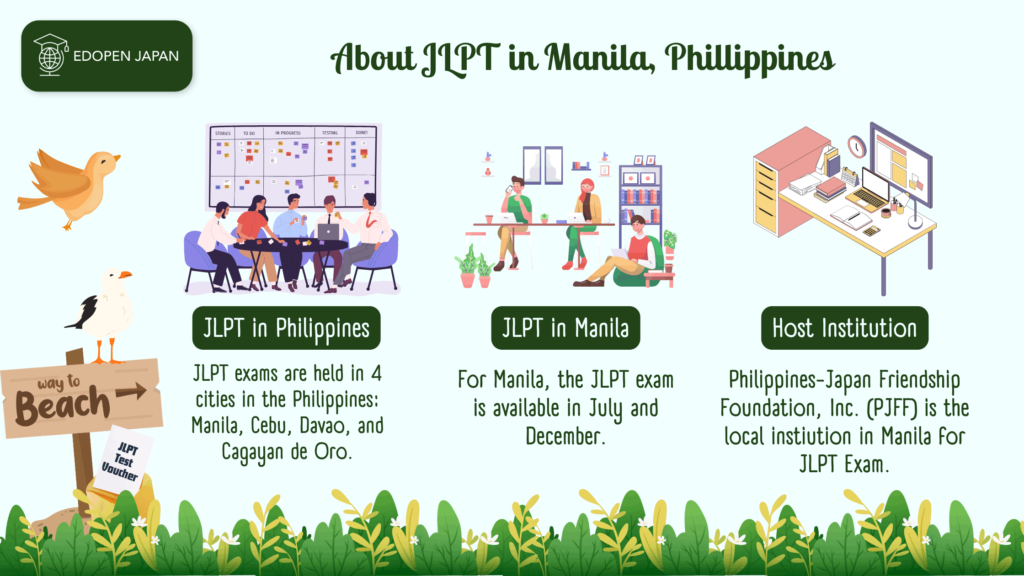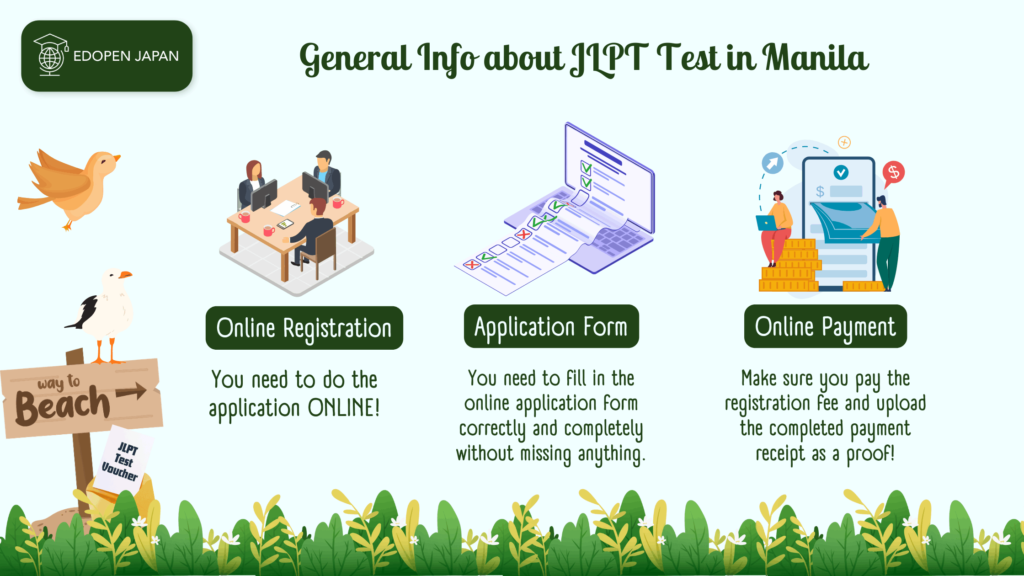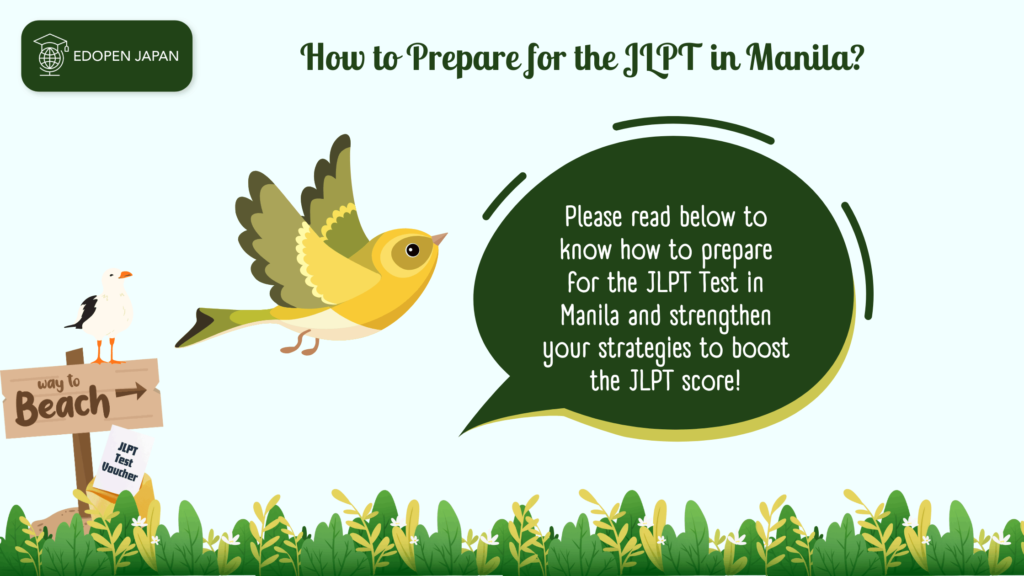Do you currently need information about the JLPT exam in Manila, Philippines? Is it really difficult to find comprehensive and up-to-date information regarding JLPT in Manila? Also, when is the JLPT exam in Manila?
You may have a myriad of even more questions like the above about the JLPT exam in Manila. Especially with the current COVID-19 pandemic, the rules for administering the JLPT exam are of course different from last year.
But don’t worry. Please take a few minutes to read this article. And you will instantly get everything you need to know about the JLPT exam in Manila.
Here, we will briefly and accurately discuss technical information about the JLPT in Manila, registration information, fees to be paid, and additional tips on how to prepare for the JLPT exam to get a high score. All right, let’s start the discussion!
Read also:
JLPT in Philippines: All You Need to Know
JLPT in Malaysia: Everything You Need to Know
10 Most Popular Places to Learn Japanese in Philippines
Contents
About JLPT

The JLPT or Japanese-Language Proficiency Test was first administered in 1984. At the beginning of its implementation, the JLPT exam was held in 15 countries with approximately 7,000 participants.[1]
Since then, the number of JLPT test takers has increased significantly to approximately 610,000 people from 62 countries around the world.[1]
By 2017, the number of JLPT participants had exceeded 1 million, and at its peak before the COVID-19 pandemic, the number of JLPT participants continued to increase to 1.36 million.[2]
Originally, the JLPT was administered only once a year. However, from 2009 to date, the JLPT exam has been administered twice a year, in July and December.[2]
In addition, 2 main organizations administer JLPT exams in Japan and overseas: Japan Educational Exchanges and Services and Japan Foundation.[3]
Both of them work together to make the JLPT exam successful every year. Especially overseas, the Japan Foundation works with local institutions to organize the JLPT exam.
The Levels of JLPT
The JLPT exam has 5 levels: N1 (most difficult), N2, N3, N4, and N5 (easiest).[4] Furthermore, N1 and N2 measure an understanding of Japanese used in a variety of real-life situations.
Meanwhile, levels N4 and N5 measure a limited understanding of basic Japanese that is only commonly used and learned in class. The N3 level is the intermediate level between these two levels.
The following is the summary of language proficiency for each JLPT level:
| JLPT Level | Reading: The participant can read writings of logical complexity and/or abstract writings on a variety of topics, such as newspaper editorials and reviews, and understand both their structure and content. Participants are also able to read written materials with profound content on various topics and follow their narratives as well as understand the intention of the writers comprehensively. Listening: Participants are expected to be able to understand oral material such as coherent conversations, news reports, and lectures, and to speak at a natural pace under a variety of conditions. |
| JLPT N1 | Reading: The participant can read writings of logical complexity and/or abstract writings on a variety of topics, such as newspaper editorials and reviews, and understand both their structure and content. Participants are also able to read written materials with profound content on various topics and follow their narratives as well as understand the intention of the writers comprehensively. Listening: Participants are expected to be able to understand oral material such as coherent conversations, news reports, and lectures, and to speak at a natural pace under a variety of conditions. |
| JLPT N2 | Reading: Participants are expected to be able to understand Japanese at a certain level in a variety of everyday situations. Participants are expected to be able to read and understand written material on a variety of topics, such as newspaper and magazine articles and commentaries. Listening: Participants are expected to be able to understand the material orally, such as coherent conversations, and news reports, at a speed close to the natural speed of native Japanese speakers. |
| JLPT N3 | Reading: Participants are expected to have some ability to understand Japanese used in everyday situations. Participants are also expected to be able to understand summary information such as newspaper headlines. Listening: The expectation is that students will be able to hear and understand coherent conversations in everyday situations at an almost natural pace. |
| JLPT N4 | Reading: Ability to understand basic Japanese. Students are expected to be able to read and understand parts of everyday topics written in basic vocabulary and Kanji. Listening: Participants are expected to be able to listen to and understand conversations in everyday situations that speak at a slow pace. |
| JLPT N5 | Reading: Participants are expected to be able to understand some basic Japanese. Be able to read and understand typical expressions and sentences written in basic hiragana, katakana, and kanji. Listening: Students are expected to be able to listen to and understand conversations in everyday and classroom situations, and to retrieve information in short, slowly spoken conversations. |
To learn more about the JLPT exam levels, please visit the official JLPT website below:
The Importance of Taking the JLPT Exam
If you ask what is the importance of taking the JLPT test? Then the answers are varied. The students, workers, and travelers will need it. Here are some examples:
- Get points that can be exchanged for special treatment from Japanese immigration. Holders of JLPT N1 and N2 certificates are considered human resources who have high skills and quality. Thus, they are given priority to take care of residence visas more easily.
- Some professions are required to take the national examination. For example, some medical professionals who are licensed from abroad must hold the JLPT N1 certificate if they want to work in Japan.
- Foreign students who have graduated from high school in Japan are required to take the Japanese Language Proficiency Test. If they pass the JLPT N1 or N2 test, they may be exempted from taking the exam in some subjects.
- Used for Japanese university entrance examinations. Japanese universities usually require the Japanese language proficiency of foreign students who will enroll in a Japanese university.
- Can be used to apply for scholarships and promotions if you work in a Japanese company in Japan or even overseas.
In addition, the JLPT exam can be a very accurate measure of how well you have mastered the Japanese language. Apart from being able to understand the Japanese language itself, you will be personally enriched by an understanding of the Japanese culture, which is also very powerful and inspiring.
About JLPT in Manila, Phillippines

JLPT exams are held in 4 cities in the Philippines: Manila, Cebu, Davao, and Cagayan de Oro. In 2023, the JLPT will be offered 2 times in each of these cities, in July and December. In addition, each city will have a local institution that will administer the JLPT on behalf of the Japan Foundation.
Specifically for Manila, the JLPT exam is available in July and December. The host institution for the JLPT exam in Manila is the Philippines-Japan Friendship Foundation, Inc. For updated information on the JLPT exam in all cities in the Philippines, please visit the following Japan Foundation Manila website:
If you want to take the JLPT exam in Manila, you will need to contact the Philippines-Japan Friendship Foundation, Inc. (PJFF) for instructions regarding the JLPT exam you are taking. We will discuss PJFF briefly below.
About Phillippines-Japan Friendship Foundation, Inc. (PJFF)
The Philippines-Japan Friendship Foundation, Inc. (PJFF) is a non-profit social foundation established in 1974.[5] The Foundation was greatly favored by the Japanese government in its early years with a $1 million grant in gratitude for the safe recovery, travel, and pardon of Lt.
Hiroo Onoda (a Japanese Army intelligence officer who remained on Lubang Island for 30 years after the end of the war).
Moreover, the PJFF has been building, maintaining, and prudently managing its portfolio of assets that allow for the expansion of financial assistance to various organizations affiliated with the Filipino-Japanese Society, while providing administrative and secretarial support for their activities and operations.
Further, the parent organization of the Foundation is the Philippine-Japanese Society. The society houses many other non-profit organizations that help educate, familiarize, and unite the people of the city of Manila to establish good relations with Japan through culture, arts, and language.
PJFF has also been appointed by the Japan Foundation as the host institution for the JLPT test in the city of Manila and the city of Manila. In this institution, the (JLPT) is administered in July and December each year, with an annual average of approximately 12,000 test-takers.
The Philippines-Japan Friendship Foundation, Inc. (PJFF)
Address: 7th Floor, Electra House Building 115-117 Esteban Street,
Legaspi Village Makati City, Philippines
email: pjff.jlpt.manila@gmail.com
General Info about the JLPT Test in Manila

According to the latest info released by PJFF, the nearest JLPT test will be held on Sunday, July 2, 2023. Then, the general registration flow is as follows:
- Candidates should inquire about the JLPT through the various local host institutions, ex: PJFF for Manila. The local host institutions will then respond to their inquiries.
- At the beginning of the registration flow (application), applicants can ask questions such as when the JLPT test will be held, when the application period is, and how much the JLPT test fee is direct to the local host institution.
- When the registration period is open, applicants can create and verify an online JLPT test account.
- Please fill in the online application form correctly and completely without missing anything. Make sure you upload a recent official photo with a 1×1 digital ID photo.
- Make sure you pay the registration fee and upload the completed payment receipt as proof of valid payment.
In addition, applicants can submit applications if all requirements have been fulfilled. Then, after successfully submitting the application form, the committee will manually review the application for each submission.
Here, you need to wait. After your application form is approved by the host institution, your voucher test can be printed in A4 size. Please refer to the latest and the other details through the following link:
Test Guide and Fee
For the JLPT Test Guide, you can contact the PJFF directly or see the information available on the Japan Foundation Manila website.
Moreover, the following is the fee for the JLPT exam that you must prepare for:
| JLPT Level | Fee |
| JLPT N1 | P 1,500.00 |
| JLPT N2 | P 1,500.00 |
| JLPT N3 | P 1,100.00 |
| JLPT N4 | P 1,100.00 |
| JLPT N5 | P 1,100.00 |
If you have any questions or difficulties in paying for the above JLPT exam, please contact Japan Foundation Manila or PJFF.
How to Register for the JLPT Test in Manila?

If you have decided to take the exam in Manila or other cities in the Philippines, then you need to understand the steps on how to register for the JLPT exam in Manila.
The following are general steps that we have summarized concerning the JLPT exam to be held on July 2023 from the Philippines-Japan Society website:
- The JLPT exam registration period opens in early to late April for the July exam, approximately 3 months before the JLPT exam date.
- You can only register as an individual. Group registration is not allowed.
- You must have received the full Covid-19 vaccine to take the JLPT exam.
- The JLPT exam registration fee is non-refundable for any reason.
- To complete the registration process, candidates must upload proof of payment.
Then, after registering, you will receive a test voucher mailed approximately 1 month before the exam. You can only register online using the link provided. Below is the registration link for the July 2023 JLPT exam in Manila:
In addition, please note that the registration link is only accessible during the registration period (April 1-20, 2023 for the July 2023 exam). Registration is not possible outside of the registration period. If you have any questions regarding the JLPT exam in Manila, you can contact the PJFF via email.
How to Prepare for the JLPT in Manila?

To prepare for the JLPT exam as well as possible, you need to pay attention to many things. Not only technical things, as we have discussed in the previous section, but also the quality of your JLPT exam preparation.
And then, to get good, effective, and focused JLPT exam preparation, you need to do it together with professionals. Therefore, we recommend that you attend a JLPT exam preparation course organized by a Japanese language institute with professional, experienced, and certified teachers.
Next, please visit the following link and read our recommendations on the best places to learn Japanese and prepare for the JLPT exam in the Philippines.
The Perfect Way to Boost the JLPT Score!
Aside from attending special JLPT test preparation classes in the Philippines, we also want to share with you special tips on how to improve your JLPT score. Not only do you need to pass the exam, but you also need to know what you need to do to get better and even perfect JLPT test scores.
One effective way is to do a lot of JLPT exam practice questions. You can do this by covering fake questions specifically designed for the JLPT exam. Currently, many books are popular and you can consider them.
Then, to make it easier for you to choose the best book, read our special recommendations on the best books for JLPT exam preparation below. If you are preparing for the JLPT N5 exam, please click on the following link:
Looking for More Information on the JLPT Test?

- Is there JLPT exam in the Philippines?
The JLPT test will be held in Manila, Cebu, Davao, and Cagayan De Oro in the Philippines. Please refer to the official committee hosting the JLPT test in the Philippines. - Can you take JLPT in another country?
You can choose JLPT tests in various locations around the world based on your location and the test date, not just in Japan. - How long is JLPT valid for?
JLPT certificates are always valid. However, it is recommended to take the test every two years to keep your language skills up to date. - Can I study in Japan without JLPT?
For international program taught in English, it is highly likely that the JLPT certificate is not required. However, for regular program, the JLPT certificate is mandatory. - Can I pass JLPT N5 in 3 months?
Studying intensively with experienced teachers can make it possible to pass the JLPT N5 level, which is the most basic level. - Is JLPT N3 enough to live in Japan?
Living and interacting on a daily basis may not require the certificate. If you wish to work in Japan, the JLPT N2 certificate is the standard requirement. - Can I give N4 without N5?
You can choose any JLPT test level without the need to pass the lowest level before taking a higher level test.
Conclusion
Well, this is the end of our discussion about the JLPT exam in Manila, Philippines. We hope that the information we have presented is useful to you. We are truly very proud to be a part of your journey to pass the JLPT exam.
Furthermore, please don’t forget to update the JLPT exam information here and please share your JLPT exam experience with us below. Alright, thank you for reading to the end. See you in the next article.
Reference
1 “Message from Organizers“. The Official JLPT Website. Retrieved 7 April 2023.
2 “Statistics“. The Official JLPT Website. Retrieved 7 April 2023.
3 “Organizers“. The Official JLPT Website. Retrieved 7 April 2023.
4 “N1-N5: Summary of Linguistic Competence Required for Each Level“. The Official JLPT Website. Retrieved 7 April 2023.
5 “About PJFF“. The Official PJFF Website. Retrieved 7 April 2023.













